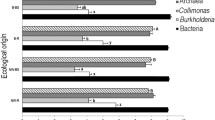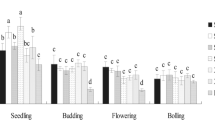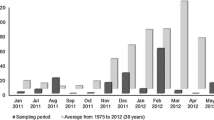Abstract
Agroforestry systems have been considered a form of sustainable land use. Woody species in agroforestry systems can improve soil physicochemical properties by supplying leaf or stem litter. However, little is known about fungal community structure and diversity in agroforestry systems. In the present study, the culture-independent 18S rDNA-based polymerase chain reaction-denaturing gradient gel electrophoresis (PCR-DGGE) method was used to investigate fungal community structure in rhizosphere and bulk soil in Populus euramevicana-barley and Taxodium distichum-barley agroforestry systems. DGGE profiling and cluster analysis revealed that the fungal community structure in the rhizosphere was more complex than that of bulk soil. Our results also indicated that the rhizosphere fungal community in barley was less affected by T. distichum than by P. euramevicana. In addition, an increase in the relative abundance of certain rhizosphere fungal populations was detected in this agroforestry system. Sequencing of prominent DGGE bands revealed an increase in the rhizosphere of a fungal species belonging to the genera Chaetomium, which includes potential biocontrol agents. A rare cellulolytic fungus, Acremonium alcalophilum, was found in the bulk soil from P. euramevicana and barley grown under P. euramevicana. Taken together, our findings may provide new insights into agroforestry practices.








Similar content being viewed by others
References
Berg G, Smalla K (2009) Plant species and soil type cooperatively shape the structure and function of microbial communities in the rhizosphere. FEMS Microbiol Ecol 68:1–13
Berg G, Zachow C, Lottmann J, Götz M, Costa R, Smalla K (2005) Impact of plant species and site on rhizosphere-associated fungi antagonistic to Verticillium dahliae kleb. Appl Environ Microbiol 71:4203–4213
Broeckling CD, Broz AK, Bergelson J, Manter DK, Vivanco JM (2008) Root exudates regulate soil fungal community composition and diversity. Appl Environ Microbiol 74:738–744
de Ridder-Duine AS, Kowalchuk GA, Klein Gunnewiek PJA, Smant W, Van Veen JA, de Boer W (2005) Rhizosphere bacterial community composition in natural stands of Carex arenaria (sand sedge) is determined by bulk soil community composition. Soil Biol Biochem 37:349–357
Dhingra OD, Mizubuti ESG, Santana FM (2003) Chaetomium globosum for reducing primary inoculum of Diaporthe phaseolorum f. sp. meridionalis in soil-surface soybean stubble in field conditions. Biol Control 26:302–310
Di Pietro A, Gut-Rella M, Pachlatko JP, Schinn FJ (1992) Role of antibiotics produced by Chaetomium globosum in biocontrol of Pythium ultimum, a causal agent of damping-off. Phytopathology 82:131–135
Edel-Hermann V, Dreumont C, Pérez-Piqueres A, Steinberg C (2004) Terminal restriction fragment length polymorphism analysis of ribosomal RNA genes to assess changes in fungal community structure in soils. FEMS Microbiol Ecol 47:397–404
Fanish SA, Priya RS (2013) Review on benefits of agroforestry system. Int J Edu Res 1:1–12
Finlay RD (2008) Ecological aspects of mycorrhizal symbiosis: with special emphasis on the functional diversity of interactions involving the extraradical mycelium. J Exp Bot 59:1115–1126
Gao K, Liu X, Kang Z, Mendgen K (2005) Mycoparasitism of Rhizoctonia solani by endophytic Chaetomium spirale ND35: ultrastructure and cytochemistry of the interaction. J Phytopathol 153:280–290
Gomes NCM, Fagbola O, Costa R, Rumjanek NG, Buchner A, Mendonca-Hagler L, Smalla K (2003) Dynamics of fungal communities in bulk and maize rhizosphere soil in the tropics. Appl Environ Microbiol 69:3758–3766
Graner G, Persson P, Meijer J, Alstrom S (2003) A study on microbial diversity in different cultivars of Brassica napus in relation to its wilt pathogen, Verticillium longisporum. FEMS Microbiol Lett 29:269–276
Haichar FZ, Marol C, Berge O, Rangel-Castro JI, Prosser JI, Balesdent J, Heulin T, Achouak W (2008) Plant host habitat and root exudates shape soil bacterial community structure. ISME J 2:1221–1230
Hartmann M, Howes CG, VanInsberghe D, Yu H, Bachar D, Christen R, Henrik NR, Hallam SJ, Mohn WW (2012) Significant and persistent impact of timber harvesting on soil microbial communities in Northern coniferous forests. ISME J 6:2199–2218
Hinsinger P, Bengough AG, Vetterlein D, Young IM (2009) Rhizosphere: biophysics, biogeochemistry and ecological relevance. Plant Soil 321:117–152
Hoshino YT, Matsumoto N (2007) Changes in fungal community structure in bulk soil and spinach rhizosphere soil after chemical fumigation as revealed by 18S rDNA PCR-DGGE. Soil Sci Plant Nutr 53:40–55
Kowalchuk G, Smit E (2004) Fungal community analysis using PCR- denaturing gradient gel electrophoresis (DGGE). In: Kowalchuk G, de Bruijn FJ, Head IM, Akkermans ADL, van Elsas JD (eds) Molecular microbial ecology manual. Kluwer Academic Publishers, Dordrecht, pp 771–788
Leite AMO, Mayo B, Rachid CTCC, Peixoto RS, Silva JT, Paschoalin VMF, Delgado S (2012) Assessment of the microbial diversity of Brazilian kefir grains by PCR-DGGE and pyrosequencing analysis. Food Microbiol 31:215–221
Manici LM, Caputo F (2010) Soil fungal communities as indicators for replanting new peach orchards in intensively cultivated areas. Eur J Agron 33:188–196
McNear DH Jr (2013) The rhizosphere-roots, soil and everything in between. Nat Educ Knowl 4(3):1
Nagai K, Sakai T, Rantiatmodjo RM, Suzuki K, Gams W, Okada G (1995) Studies on the distribution of aikalophilic and alkali-tolerant soil fungi I. Mycoscience 36:247–256
O'Callaghan M, Lorenz N, Gerard EM (2006) Characterization of phylloplane and rhizosphere microbial populations using PCR and denaturing gradient gel electrophoresis (DGGE). In: Cooper JE, Rao JR (eds) Molecular approaches to soil, rhizosphere and plant microorganism analysis. CABI international, Oxfordshire, UK, pp 99–115
Ogino A, Koshikawa H, Nakahara T, Uchiyama H (2001) Succession of microbial communities during a biostimulation process as evaluated by DGGE and clone library analyses. J Appl Microbiol 91:625–635
Pande M, Tarafdar JC (2004) Arbuscular mycorrhizal fungal diversity in neem-based agroforestry systems in Rajasthan. Appl Soil Ecol 26:233–241
Pereira EO, Tsang A, McAllister TA, Menassa R (2013) The production and characterization of a new active lipase from Acremonium alcalophilum using a plant bioreactor. Biotechnol Biofuels 6:111
Pontius A, Krick A, Kehraus S, Brun R, König GM (2008) Antiprotozoal activities of heterocyclic-substituted xanthones from the marine-derived fungus Chaetomium sp. J Nat Prod 71:1579–1584
Reynolds PE, Simpson JA, Thevathasan NV, Gordon AM (2007) Effects of tree competition on corn and soybean photosynthesis, growth, and yield in a temperate tree-based agroforestry intercropping system in southern Ontario, Canada. Ecol Eng 29:362–371
Saito A, Ikeda S, Ezura H, Minamisawa K (2007) Microbial community analysis of the phytosphere using culture-independent methodologies. Microbes Environ 22:93–105
Smalla K, Wieland G, Buchner A, Zock A, Parzy J, Kaiser S, Roskot N, Heuer H, Berg G (2011) Bulk and rhizosphere soil bacterial communities studied by denaturing gradient gel electrophoresis: plant-dependent enrichment and seasonal shifts revealed. Appl Environ Microbiol 67:4742–4751
Somers E, Vanderleyden J, Srinivisam M (2004) Rhizosphere bacterial signaling: a love parade beneath our feet. Crit Rev Microbiol 30:205–240
Tamura K, Stecher G, Peterson D, Filipski A, Kumar S (2013) MEGA6: molecular evolutionary genetics analysis version 6.0. Mol Biol Evol 30:2725–2729
Tangjang S, Arunachalam K, Arunachalam A, Shukla AK (2009) Microbial population dynamics of soil under traditional agroforestry systems in northeast India. Res J Soil Biol 1:1–7
Thompson JD, Gibson TJ, Plewniak F, Jeanmougin F, Higgins DG (1997) The Clustal X windows interface: flexible strategies for multiple sequence alignment aided by quality analysis tools. Nucleic Acids Res 24:4876–4882
Thorn G (1997) The fungi in soil. In: van Elsas JD, Trevors JT, Wellington EMH (eds) Modern soil microbiology. Marcel Dekker Inc, New York, pp 63–127
Udawatta RP, Kremer RJ, Garrett HE, Anderson SH (2009) Soil enzyme activities and physical properties in a watershed managed under agroforestry and row-crop systems. Agric Ecosyst Environ 131:98–104
Uren NC (2000) Types, amounts and possible functions of compounds released into the rhizosphere by soil grown plants. In: Pinton R, Varani Z, Nanniperi P (eds) The rhizosphere: biochemistry, and organic substances at the soil interface. Marcel Dekker Inc., New York, pp 19–40
Vainio EJ, Hantula J (2000) Direct analysis of wood-inhabiting fungi using denaturing gradient gel electrophoresis of amplified ribosomal DNA. Mycol Res 104:927–936
Vallejo VE, Arbeli Z, Terán W, Lorenz N, Dick RP, Roldan F (2012) Effect of land management and Prosopis juliflora (Sw.) DC trees on soil microbial community and enzymatic activities in intensive silvopastoral systems of Colombia. Agric Ecosyst Environ 150:139–148
van Elsas JD, Duarte GF, Keijzer-Wolters A, Smit E (2000) Analysis of the dynamics of fungal communities in soil via fungal-specific PCR of soil DNA followed by denaturing gradient gel electrophoresis. J Microbiol Method 43:133–151
Vaz-Moreira I, Egas C, Nunes OC, Manaia CM (2011) Culture-dependent and culture-independent diversity surveys target different bacteria: a case study in a freshwater sample. Antonie Van Leeuwenhoek 100:245–257
Yu ZT, Morrison M (2004) Comparisons of different hypervariable regions of rrs genes for use in fingerprinting of microbial communities by PCR-denaturing gradient gel electrophoresis. Appl Environ Microbiol 70:4800–4806
Zachow C, Berg C, Müller H, Meincke R, Komon-Zelazowska M, Druzhinina IS, Kubicek CP, Berg G (2009) Fungal diversity in the rhizosphere of endemic plant species of Tenerife (Canary Islands): relationship to vegetation zones and environmental factors. ISME J 3:79–92
Acknowledgments
This study was funded by the National Forestry Public Welfare Industry Research Project (201304211), the Collaborative Innovation Plan of Jiangsu Higher Education, the Priority Academic Program Development of Jiangsu Higher Education Institutions (PAPD), and Central Government Funding of Forestry Science and Technology Demonstration Projects ([2012]TJS1). The authors are grateful to the anonymous reviewers for their valuable suggestions.
Author information
Authors and Affiliations
Corresponding author
Ethics declarations
Conflict of Interest
The authors declare that they have no conflict of interest.
Additional information
Qiang Zhang and Min Zhang have contributed equally to this work.
Rights and permissions
About this article
Cite this article
Zhang, Q., Zhang, M., Zhou, P. et al. Impact of tree species on barley rhizosphere-associated fungi in an agroforestry ecosystem as revealed by 18S rDNA PCR-DGGE. Agroforest Syst 92, 541–554 (2018). https://doi.org/10.1007/s10457-017-0086-5
Received:
Accepted:
Published:
Issue Date:
DOI: https://doi.org/10.1007/s10457-017-0086-5




